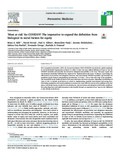‘Most at risk’ for COVID19? The imperative to expand the definition from biological to social factors for equity
Date
2020-08-06Publisher
ElsevierAuthor
Afifi, Rima A.Novak, Nicole
Gilbert, Paul A.
Pauly, Bernadette
Abdulrahim, Sawsan
Rashid, Sabina Faiz
Ortegae, Fernando
Ferrand, Rashida A.
Metadata
Show full item recordCitation
Afifi, R. A., Novak, N., Gilbert, P. A., Pauly, B., Abdulrahim, S., Rashid, S. F., . . . Ferrand, R. A. (2020). ‘Most at risk’ for COVID19? the imperative to expand the definition from biological to social factors for equity. Preventive Medicine, 139 doi:10.1016/j.ypmed.2020.106229Abstract
First recognized in December 2019, the Coronavirus Disease 2019 (COVID19) was declared a global pandemic by the World Health Organization on March 11, 2020. To date, the most utilized definition of ‘most at risk’ for COVID19 morbidity and mortality has focused on biological susceptibility to the virus. This paper argues that this dominant biomedical definition has neglected the ‘fundamental social causes’ of disease, constraining the effectiveness of prevention and mitigation measures; and exacerbating COVID19 morbidity and mortality for population groups living in marginalizing circumstances. It is clear - even at this early stage of the pandemic - that inequitable social conditions lead to both more infections and worse outcomes. Expanding the definition of ‘most at risk’ to include social factors is critical to implementing equitable interventions and saving lives. Prioritizing populations with social conditions is necessary for more effective control of the epidemic in its next phase; and should become standard in the planning for, and prevention and mitigation of all health conditions. Reversing disparities and health inequities is only possible through an expansion of our ‘most-at-risk’ definition to also include social factors.

